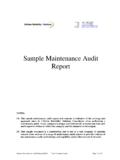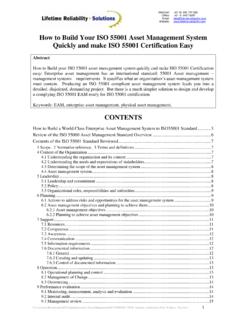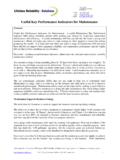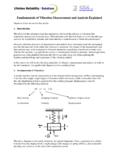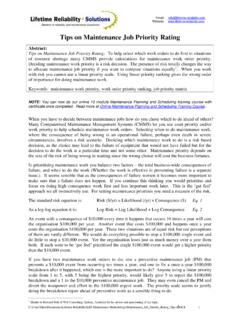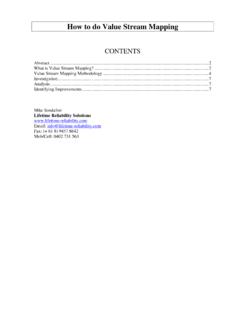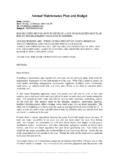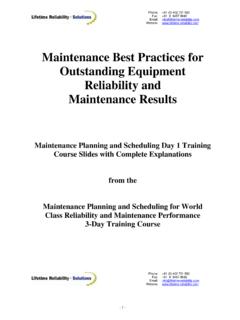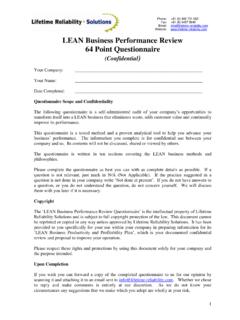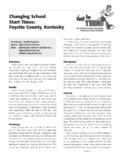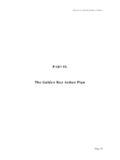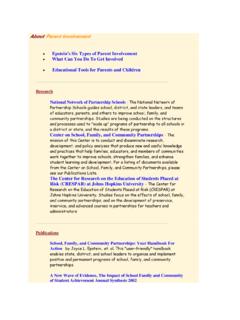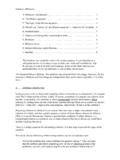Transcription of What is Equipment Reliability and How Do You Get It
1 Page 1 of 12 what is Equipment Reliability and How Do You Get It? By Mike Sondalini and Howard Witt Abstract High Equipment Reliability is a choice and not an accident of fortune. To a great extent you can choose how long you want between Equipment failures. You can deliver high Equipment Reliability by ensuring the chance of incidents that cause failures of Equipment parts are low. The secret to remarkably long and trouble-free Equipment lives is to keep parts and components at low stress, within good local environmental conditions, so there is little risk they are unable to handle their design duty. If there is nothing to cause a failure, the failure will not happen and your Equipment continues in service at full capacity and full availability. For maintenance practitioners, it is the use of precision maintenance backed-up with condition monitoring applied as a tool to prove maintenance work is done precisely, that provides the foundation for exceptional Equipment Reliability .
2 Keywords: Equipment Reliability , downtime, failure avoidance, precision maintenance, plant availability, Equipment risk reduction, condition monitoring, Reliability growth, hidden factory Without getting into the mathematics, Equipment Reliability is a measure of the odds that an item of Equipment will last long enough to do its duty. It is a measure of the chance of remaining in-service to a point in time. You measure the Reliability of Equipment by its trouble-free time. If it is meant to last for 10,000 hours (about 14 months of continuous operation), and does last that long, it is 100% reliable to 10,000 hours. But if after 10,000 hours there is an occasional failure, the Reliability beyond 10,000 hours is less than 100%. When we talk about Reliability , we must also say what time period is involved. When Equipment operates at duty capacity for as long as expected, it is considered reliable.
3 When the period between out-of-service episodes is too short, it is unreliable. Equipment Reliability needs to be seen as more than just a chance time span. It is about building great businesses that are world-class performers. High- Reliability organizations expect Equipment to last a long time and are unhappy when it does not. Not only are they unhappy, but they take effective measures to learn and improve from the failures. You have to deeply want the production and profit benefits Equipment Reliability brings before you will do what is necessary to get it. If you want plant and Equipment to operate trouble-free for a long time, you must do those activities that cause Reliability , and do them well enough to deliver Reliability . You get great Equipment Reliability when you act to control happenstance across the life-cycle and replace it with masterly precision. If you want high Reliability with low cost, put into place the necessary engineering, purchasing, storage, operating and maintenance regimes and practices that deliver the Reliability and life-cycle costs you want.
4 You may have limited opportunity to influence any of these regimes on your plant. In that case, start by looking to get more value from the Equipment you have. Improve those plant items with lower than desired Reliability - the bad-actors . You can do that by using operating practices that reduce Equipment risk and by improving machinery health. Use cross-functional teams of operators, trades people, condition monitoring technicians and engineers tasked to understand the causes of a problem and to eliminate or reduce them. Spot the onset of problems and take pre-Page 2 of 12 emptive action. Have contingency plans to mitigate consequences. Operate and maintain plant to precision standards. These risk reduction practices will deliver higher plant Reliability . Measuring the Impact of Equipment Reliability on a Business The standard definition of Reliability leaves much unsaid about the effects of Equipment failure on businesses and people.
5 You know when you have unreliable plant and Equipment because people are angry that it fails so often. In companies with Equipment Reliability problems people are busy doing , often repairing failures over and over again. It never ends, and you go home each day knowing there will be more troubles tomorrow. You also know when you have reliable Equipment because it performs as its design intended without failures. The business likely makes good profits with low operating costs controlled to a narrow, known range. You have the time to do your work well. A place with reliable Equipment is a happy and safe place. Measuring Equipment Reliability is important if you want to improve it. Reliability is measured as the average time between failures, known as Mean Time Between Failure (MTBF). One drawback with only measuring time is that there is no indication of the value of that level of Reliability . If you do not know what Reliability is worth, you may spend lots of money on small improvements that have little impact on profitability.
6 Or worst still, not spend enough money on highly profitable improvements. Reliability measured only by expected time in service is a poor business indicator. As Benjamin Franklin, the publisher of Poor Richard's Almanack 1733, said, Time is money. Reliability must also be measured by the money made or lost for the business. A measure of improving Reliability needs to show improving profitability. For a company that measures production by weight a standard profitability indicator that reflects Reliability is: Unit Cost of Production ($/T) = Operating Costs in the Period ($) Total Saleable Throughput (Tonnage) Figure 1 shows you what these measures indicate. Figure 1 Reliability ought to Measure Time and Operating Cost Time (Hrs) Duty Failure Duty Failure Available for Service Available for Service Production Time to Repair Time to Repair All Operating Costs in Period Failure Costs Spent Maintenance Costs CM/Lube Time (Hrs) Production Stoppage Production Production Production Stoppage + + Saleable Throughput Page 3 of 12 Let s take a simple example of a plant intended to operate for another 10 years (87,600 Hr) producing 1,000 T/Hr which currently has only 90% Availability due to Equipment breakdowns.
7 If it continues to be run with unimproved Reliability , it will lose 876 hours of potential production per year, or over 5 weeks lost yearly, which represents about 10% of annual production. For a plant where little attention has been paid to Reliability improvement it is possible to double MTBF ( halve the number of breakdowns) using failure elimination methods such as precision maintenance, and machinery improvement projects aimed at defect removal. With focused efforts on better planning, improved maintainability and skills upgrading, the MTTR (Mean Time To Repair) for maintenance work could be halved. Of the 5 plus weeks lost we could expect to recover weeks with the above strategy. That is an additional 507 hours per year and represents an increase from 90% to above 97% Availability. Under this simple example the effect on the Unit Cost of Production is to lift the Saleable Throughput by 7% while driving costs down.
8 In halving the breakdowns the direct maintenance component of the Operating Cost (such as parts, manpower, and supervision) falls markedly. To this must be added the huge reductions in indirect costs, plus the opportunity and knock-on costs no longer lost. Together these three cost categories can easily be ten times the value of the direct maintenance saved. In such a case, for every $1,000 dollars of direct maintenance cost reduction through improved Reliability , you also gain back $10,000 in additional profit previously lost. Improved Reliability causes throughput to rise, lowers direct production cost and avoids consequential business-wide losses. On a graph of the Unit Cost of Production over several periods you would happily see a falling trend as the Reliability growth strategy changes the place. Unit Cost of Production provides a means to show the effect of Reliability in real money and production.
9 Higher Reliability reduces the unit cost in three ways - you get more time to make product, you get more product out, you keep the earnings the business would have lost from failures. As Reliability improves there is more production time, throughput and added profit. That is why every company wants more reliable Equipment ; there is a lot of money to be made from plant Reliability improvement. Of course there is a price to make the needed changes. Making plant access refinements, doing Equipment design upgrades and training tradesmen and operators in higher and better skills is added expense and takes time. But when you can show people returns on investment measured in the hundreds of percent, you will get the management support and capital you need. We now have two measures to show the impact of Equipment Reliability improvements increased Hours between Duty Failures and reduced Unit Cost of Production over a time period.
10 These are all-encompassing measures that include the effect of everything impacting the Equipment s Reliability . To actually improve Equipment Reliability we need to rip those measures apart and look inside them to find what caused those results. It is best if you know the costs spent on an item of Equipment , exactly what they were spent on, and what they were spent to do. If you do not have good records of Equipment problems, with their associated costs and changed conditions over the Equipment life, it will probably be difficult identifying suitable maintenance actions and preparing justifications to fix them. To get the detail needed to fully analyse the cause of your Reliability problems requires tracking the life and cost of your Equipment down to the individual part level. The secret to successful Equipment Reliability lies within the lives of your Equipment s parts. Page 4 of 12 Equipment Reliability Depends on the Reliability of Parts and Components Equipment is made of parts and components combined in assemblies that work together to allow it to operate.
